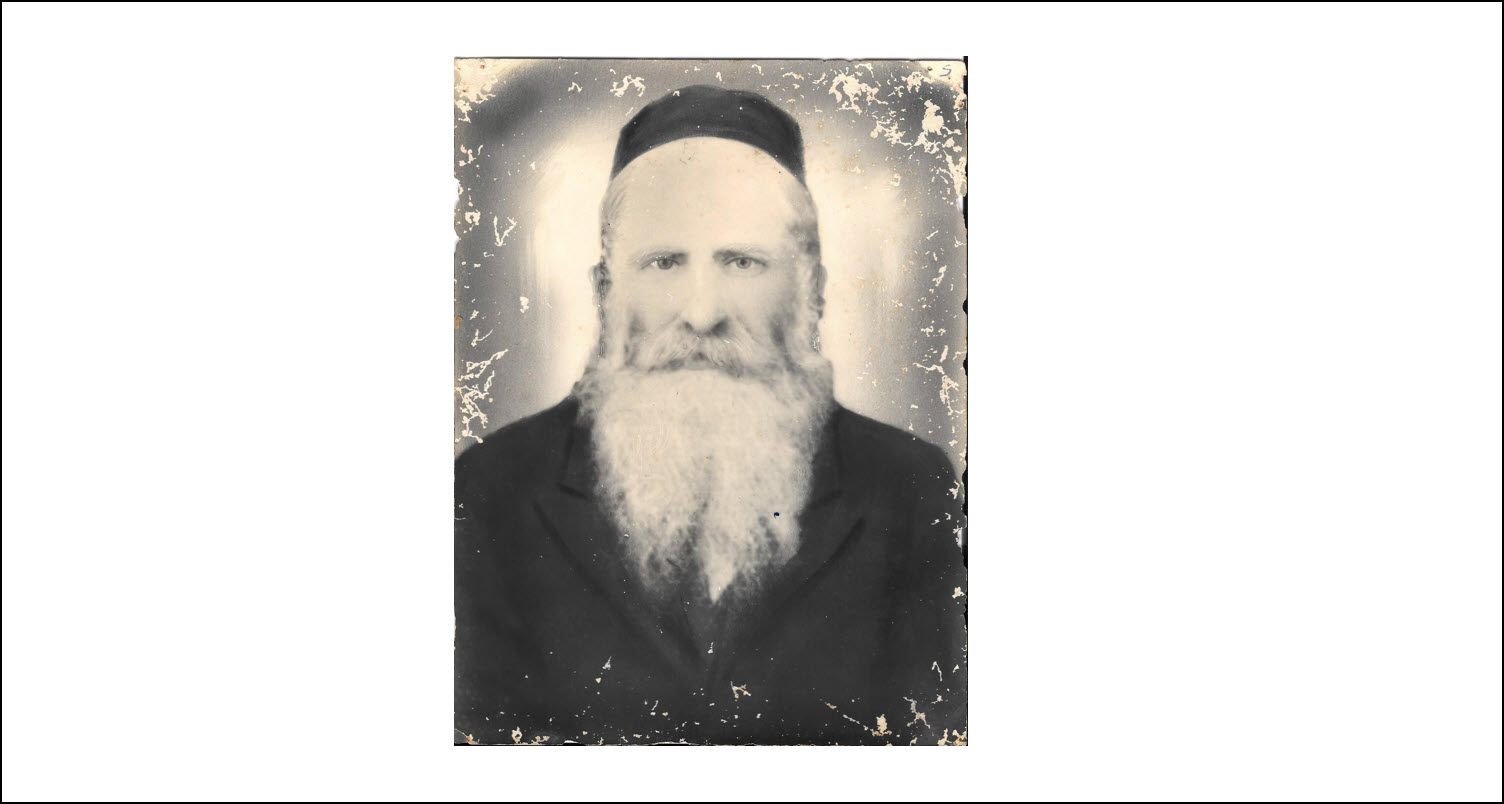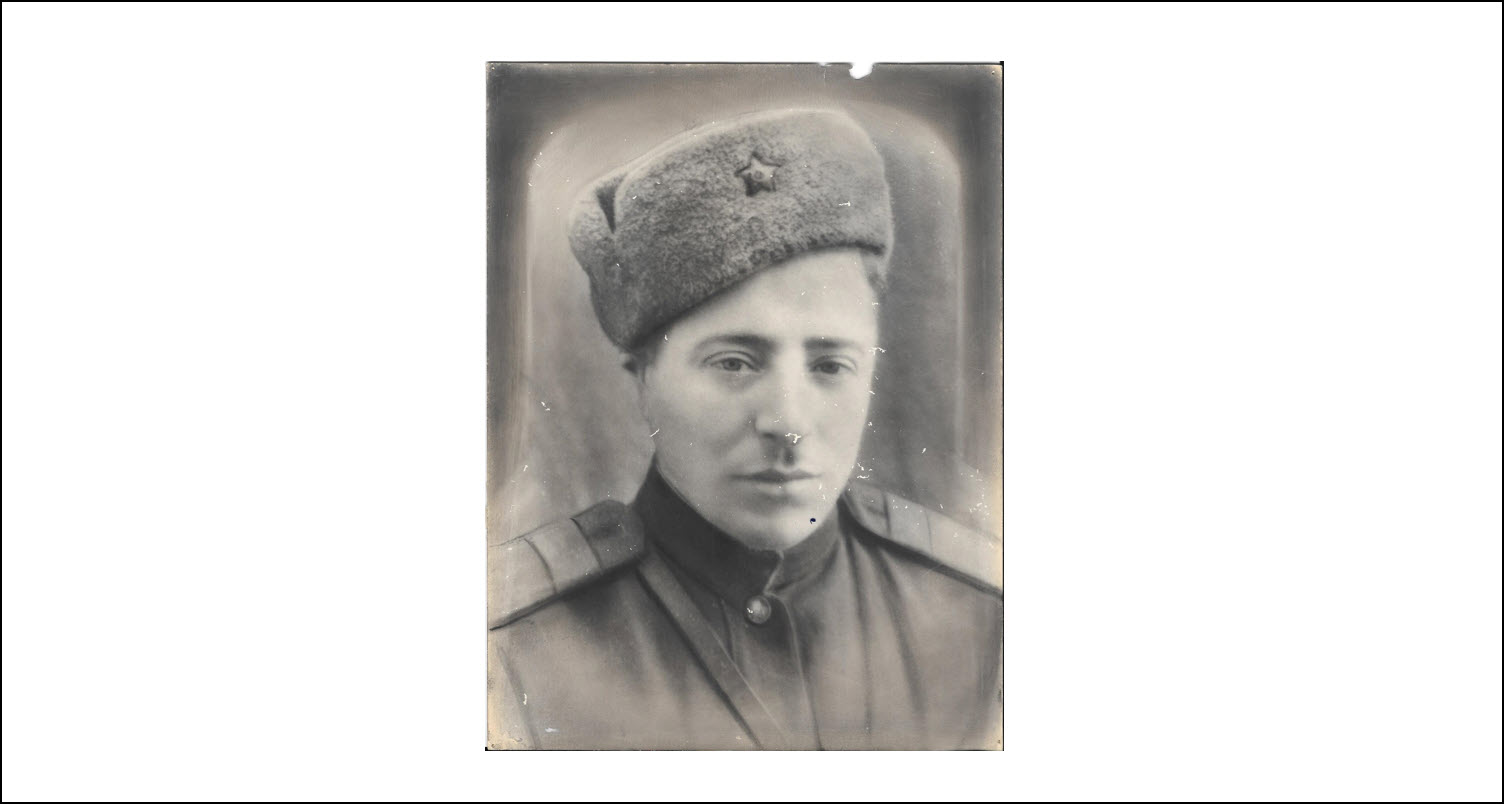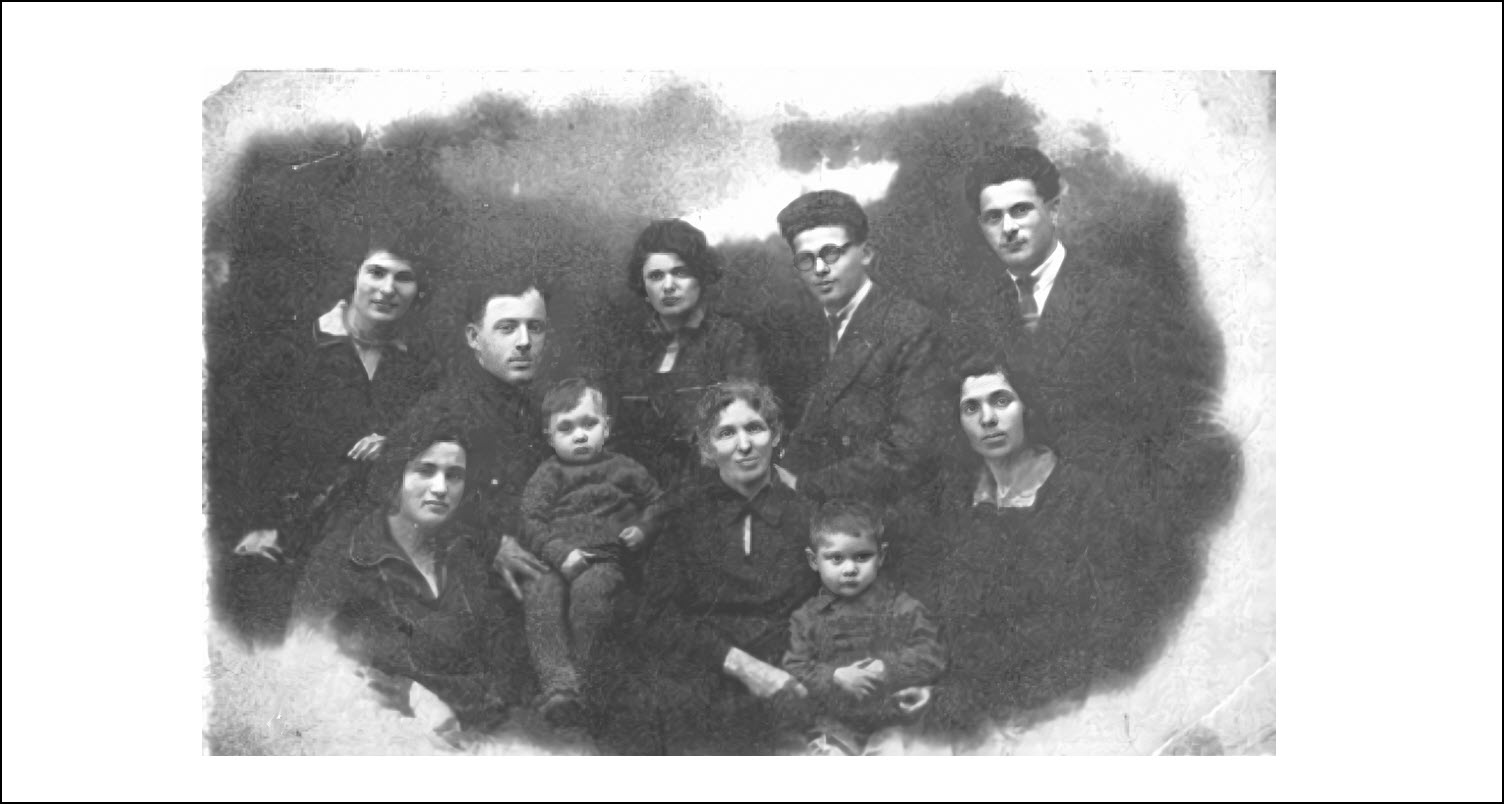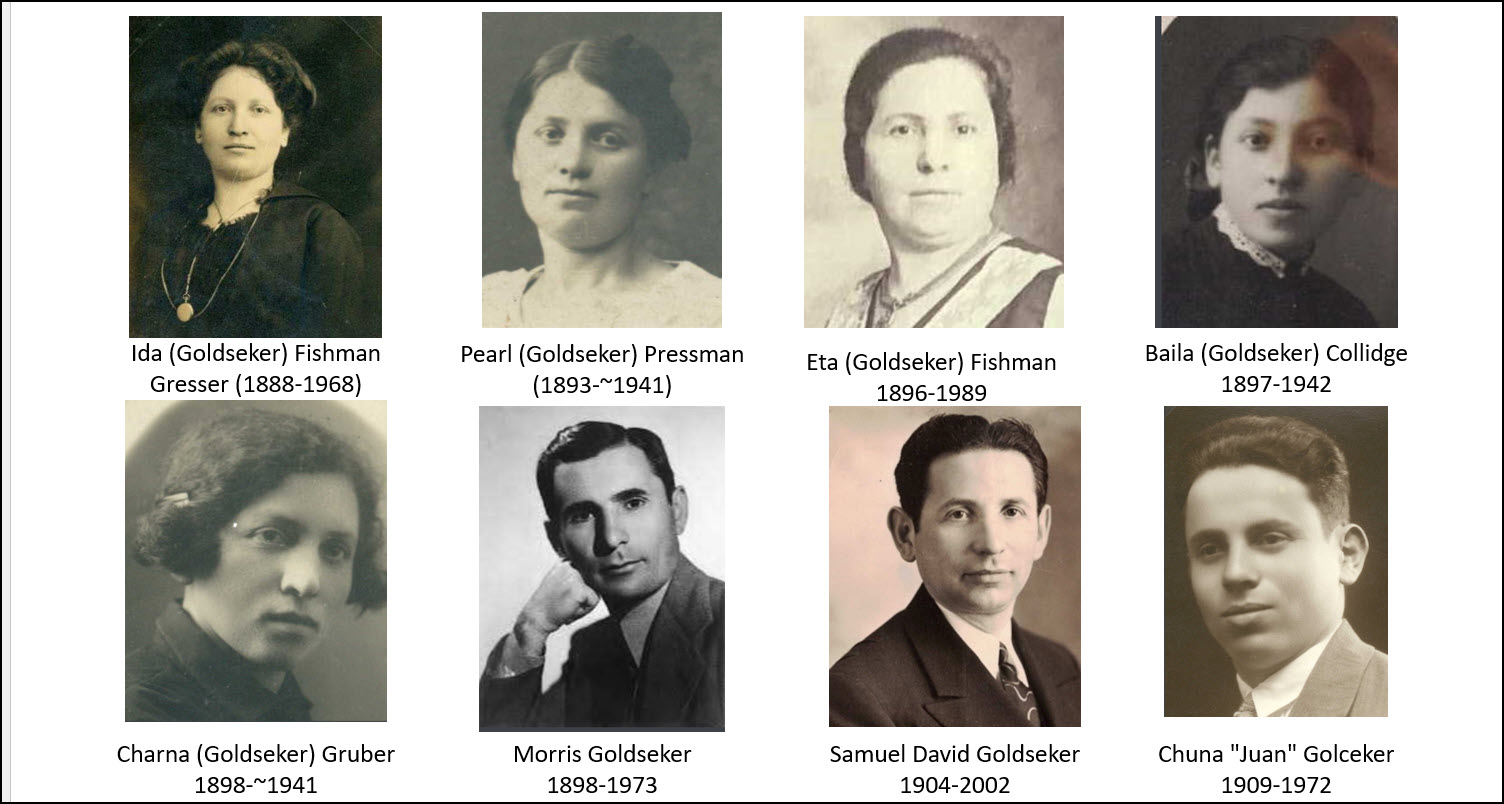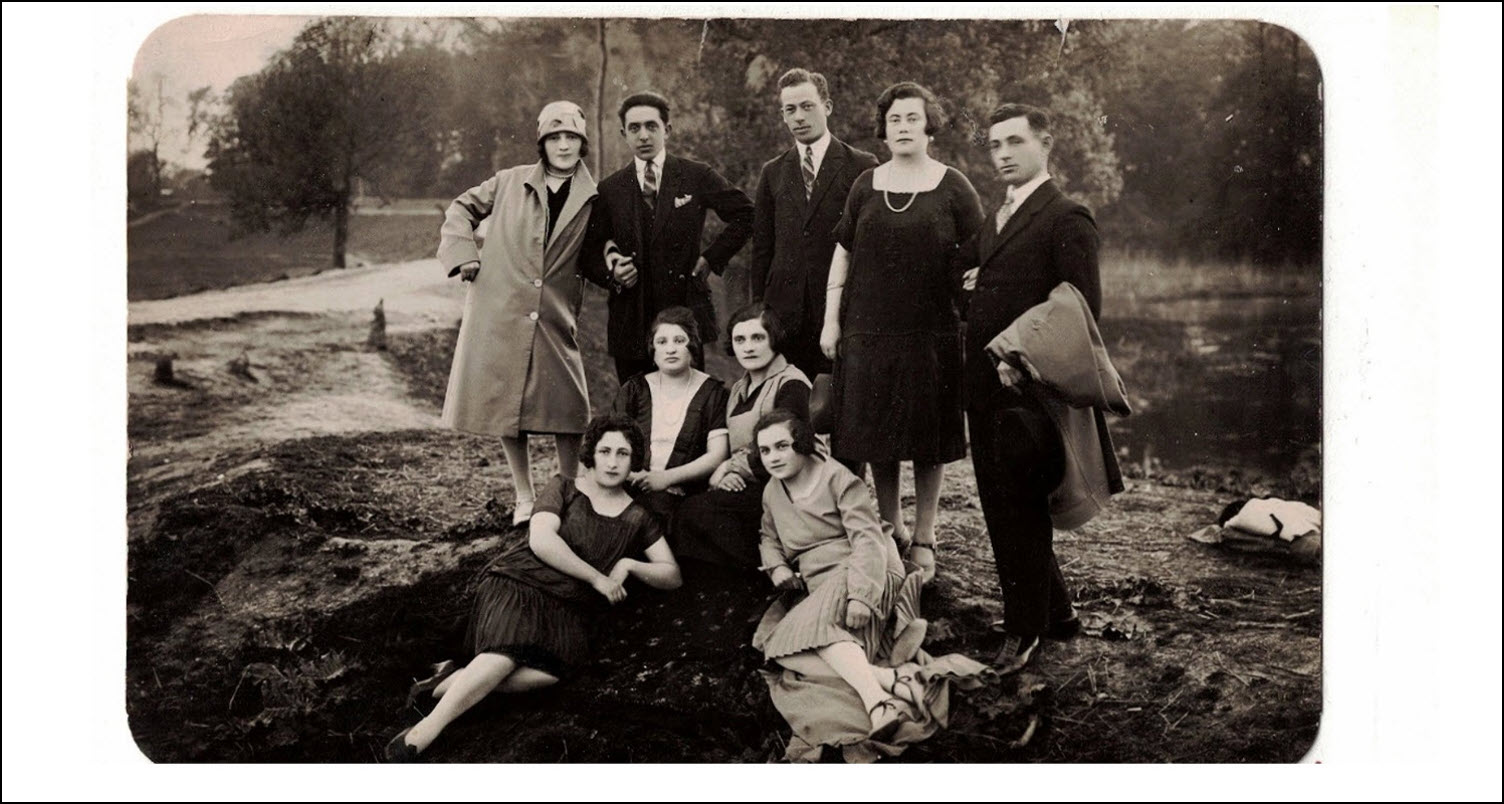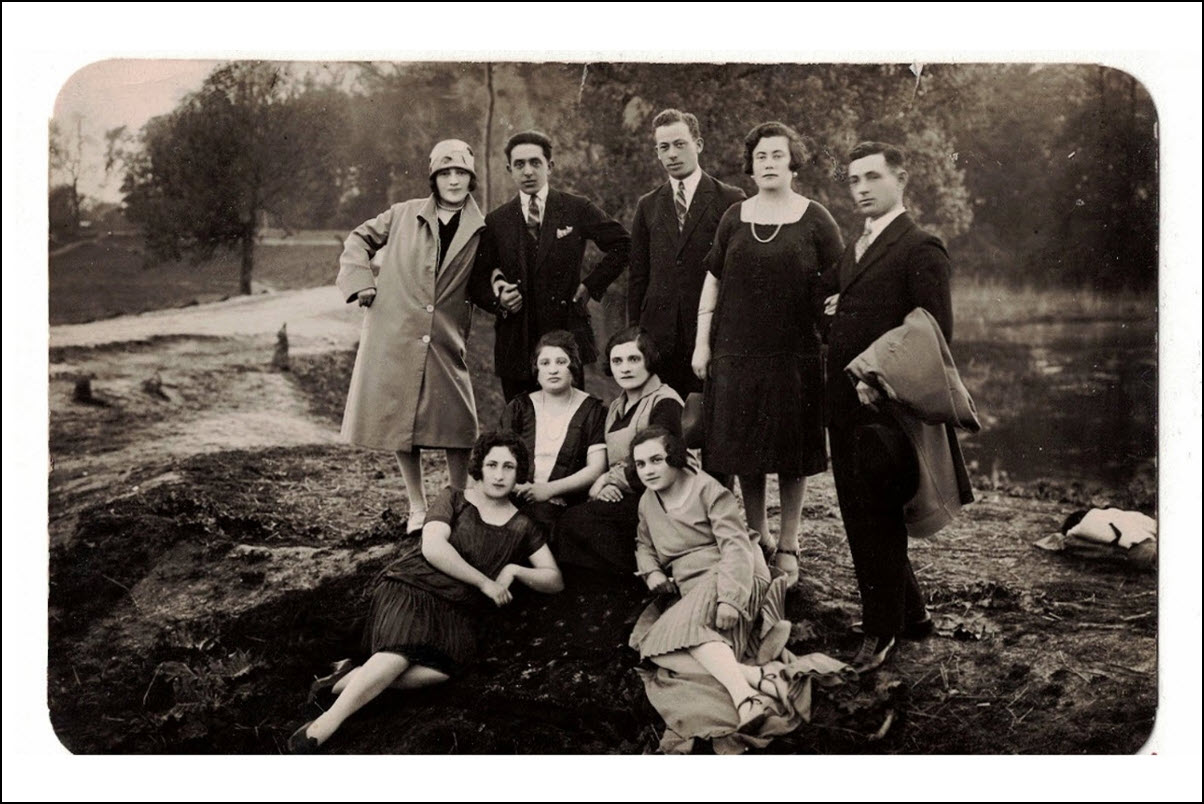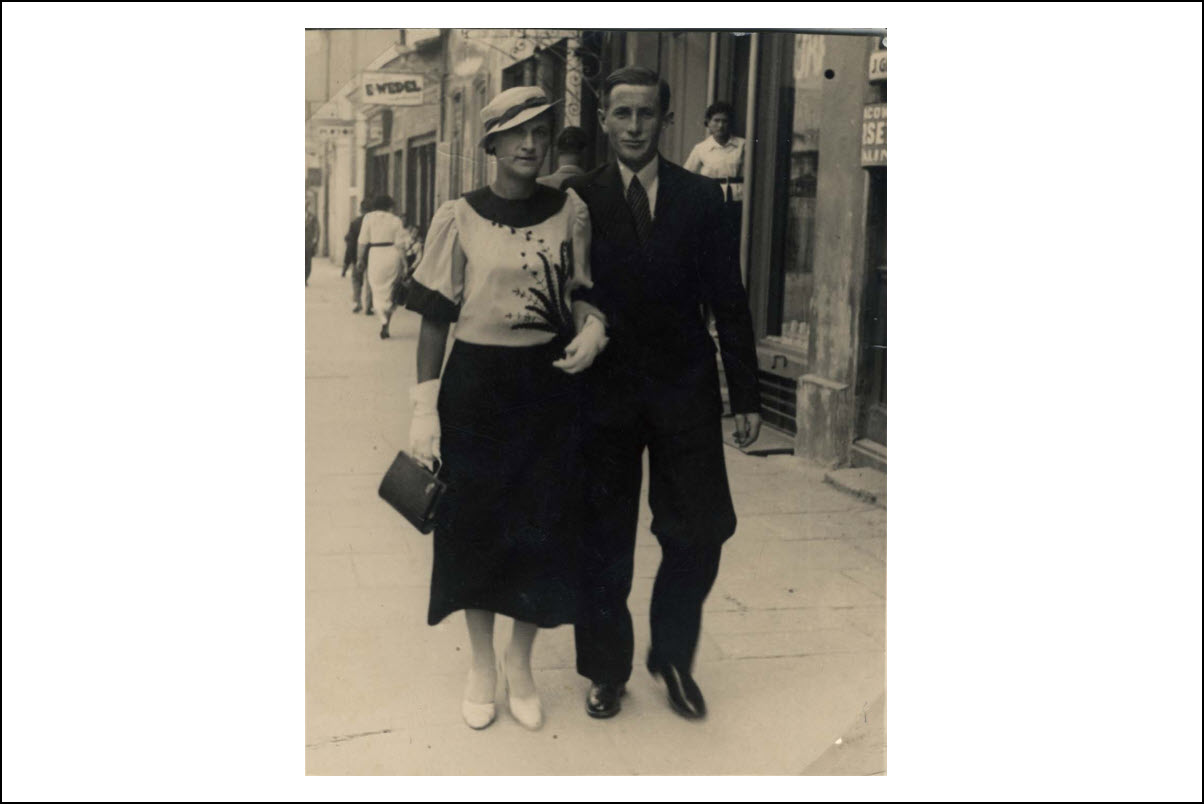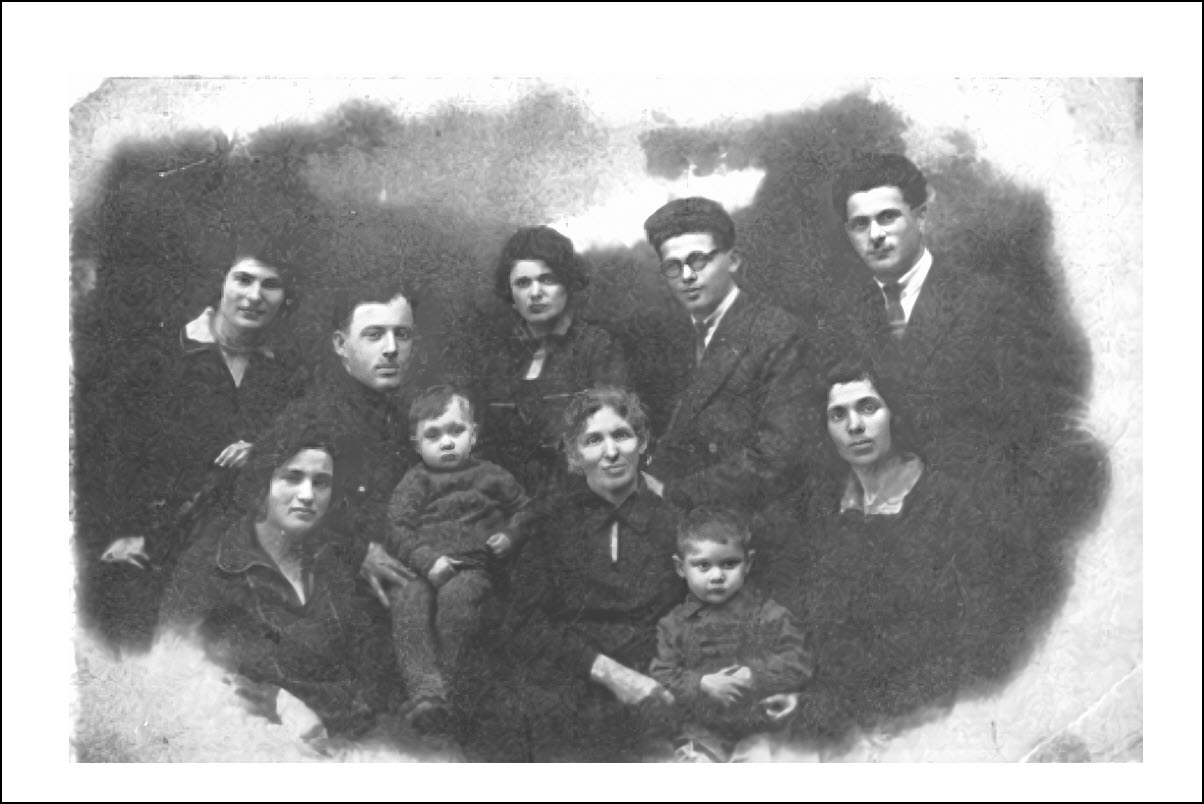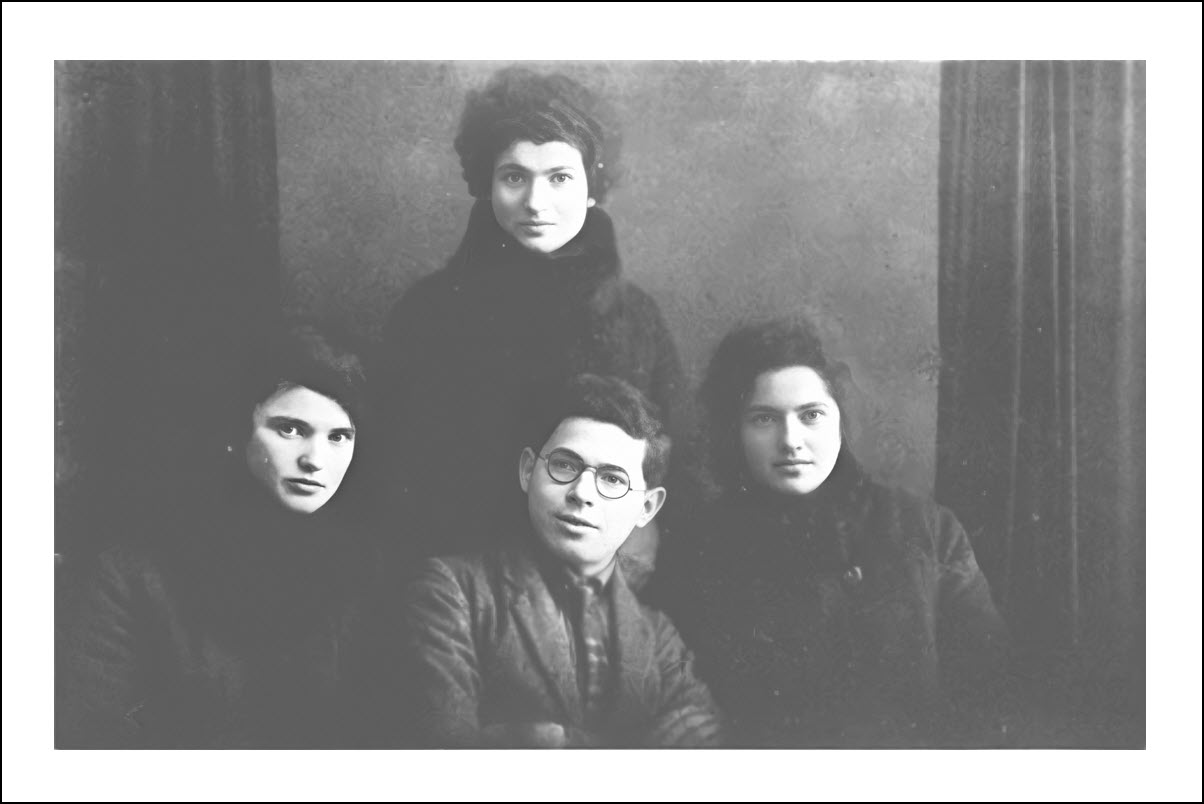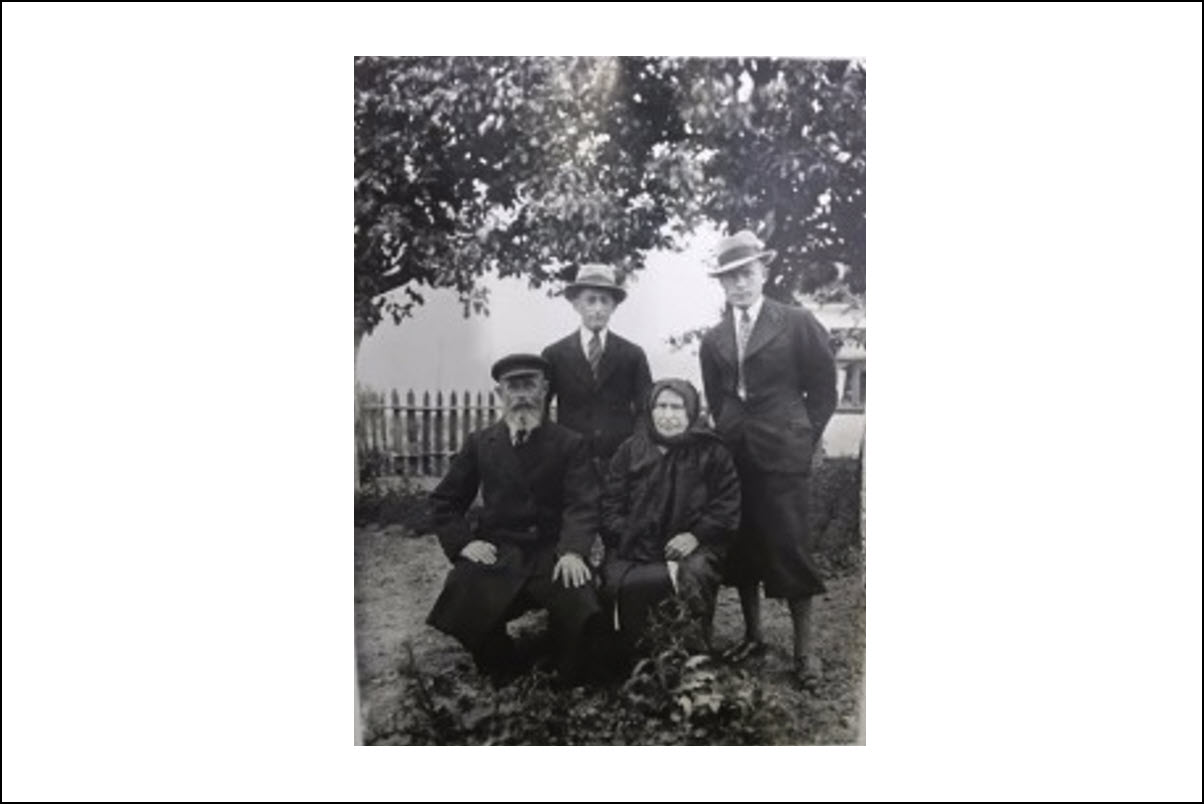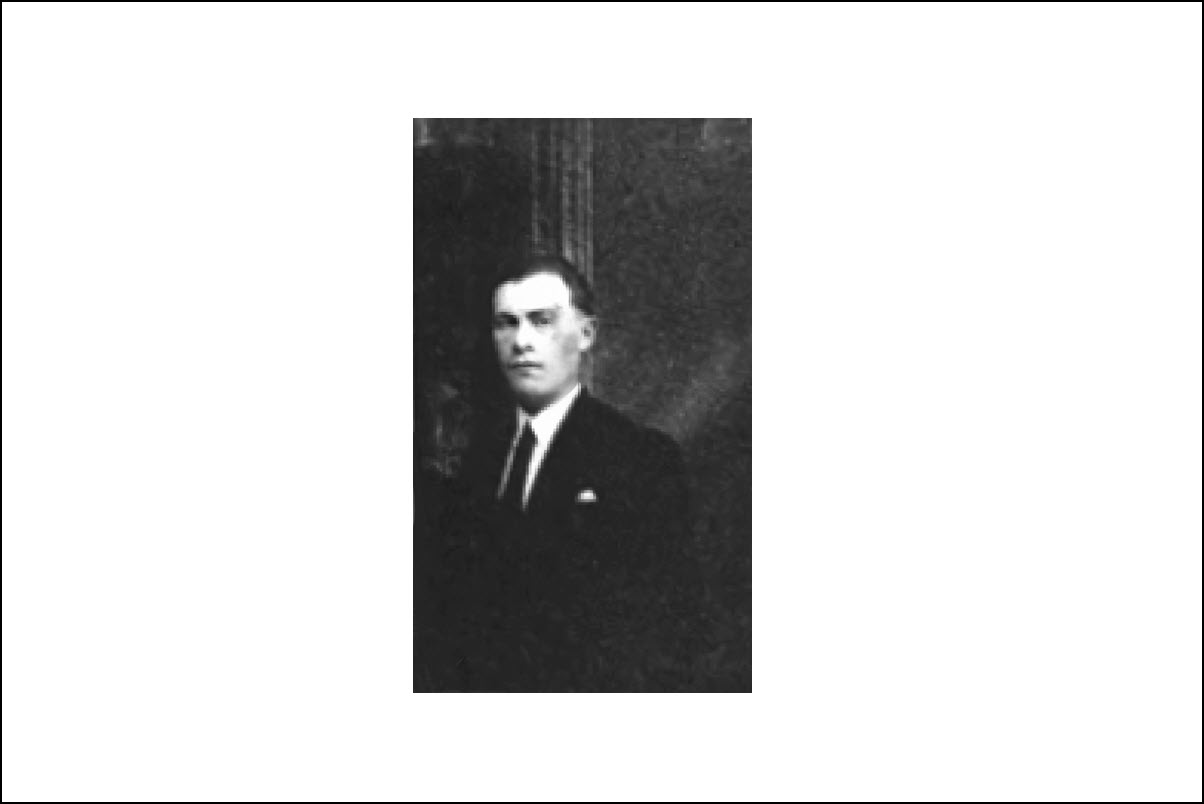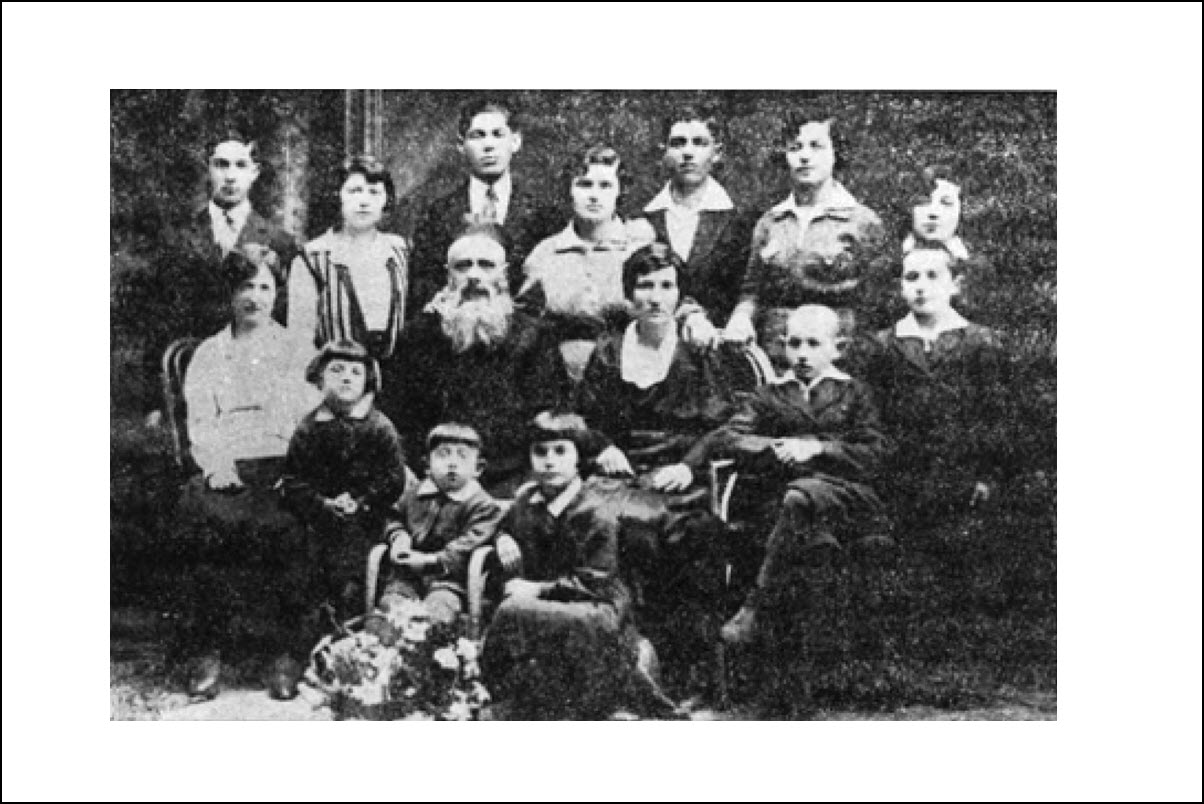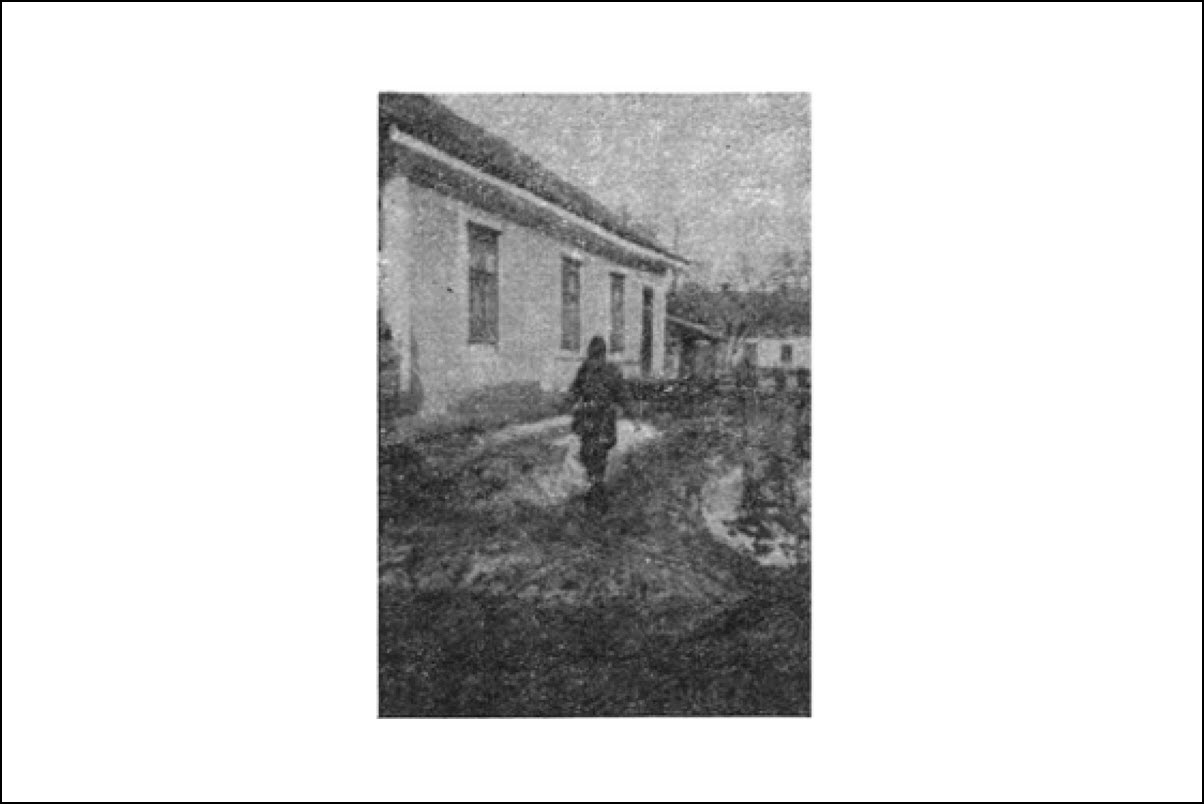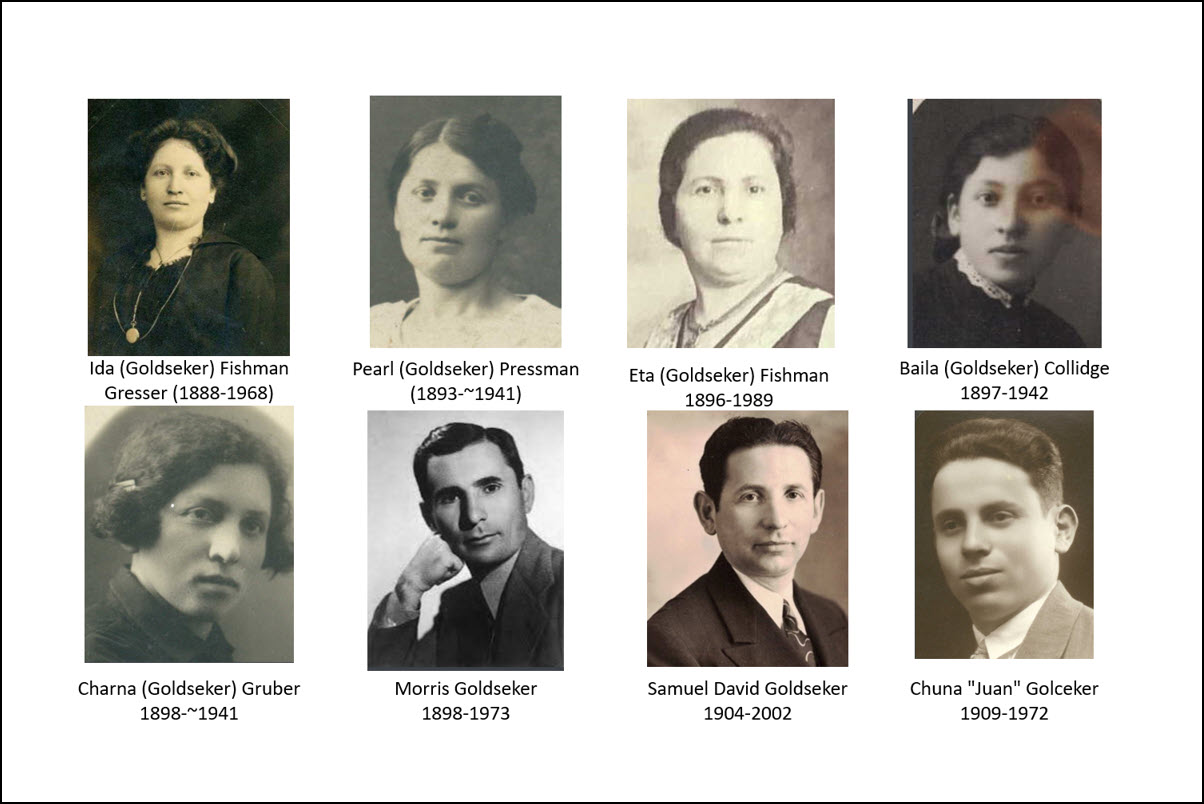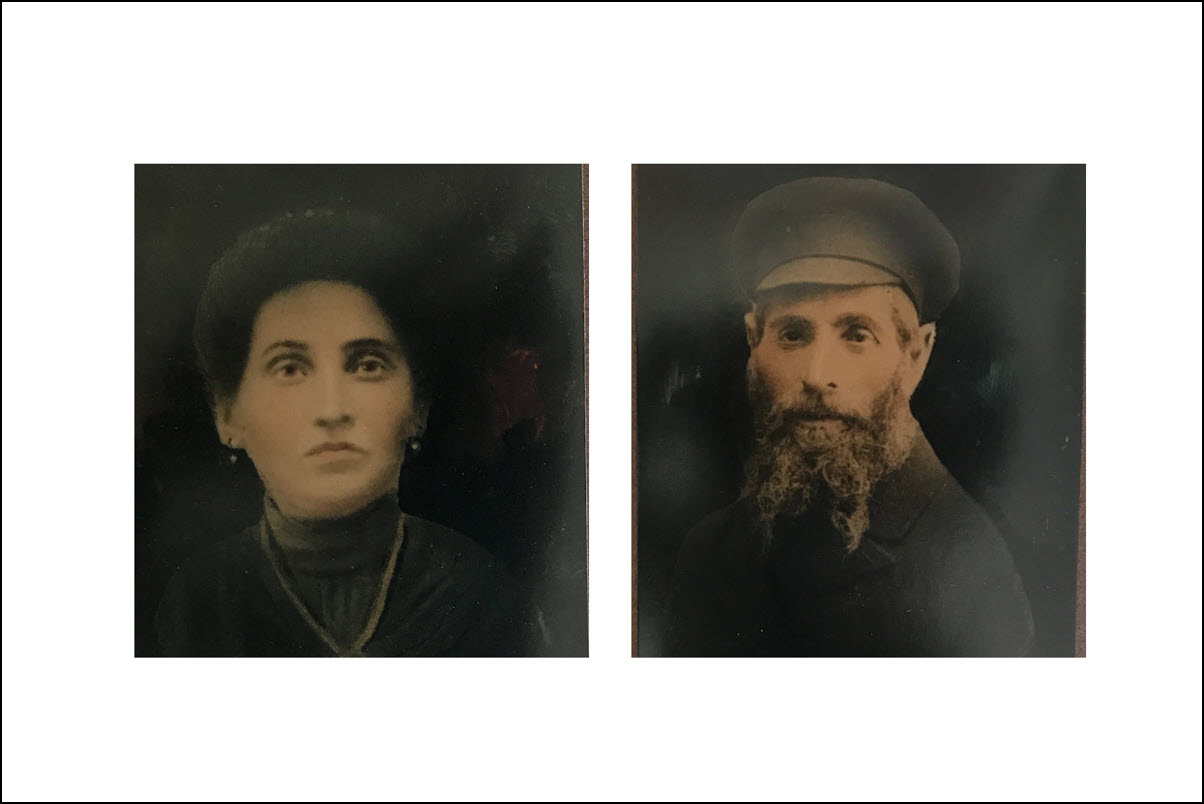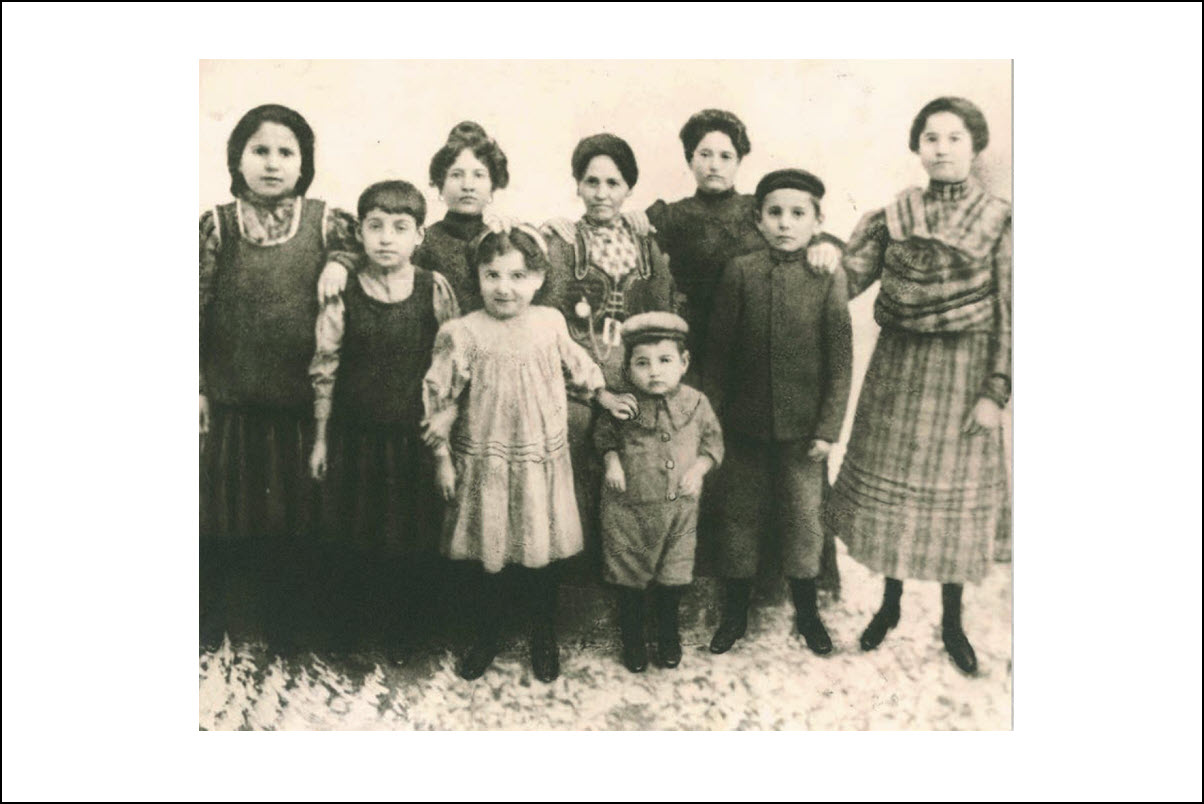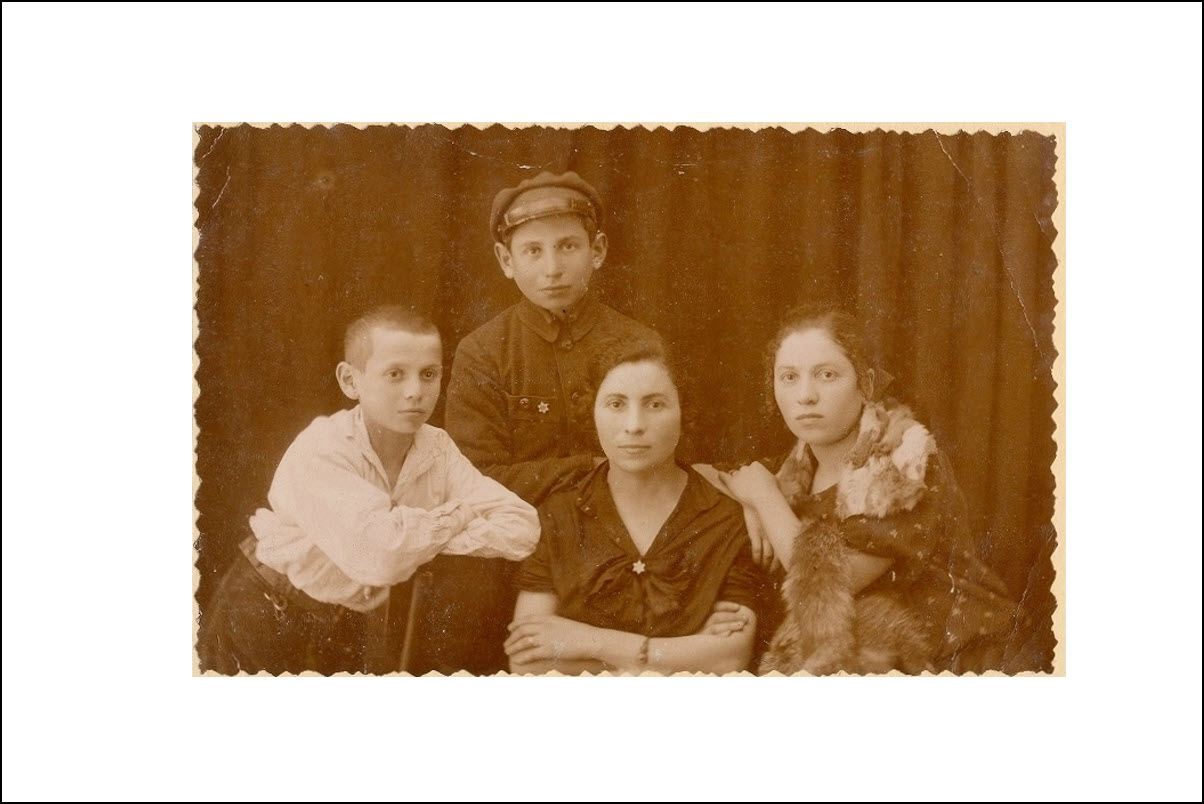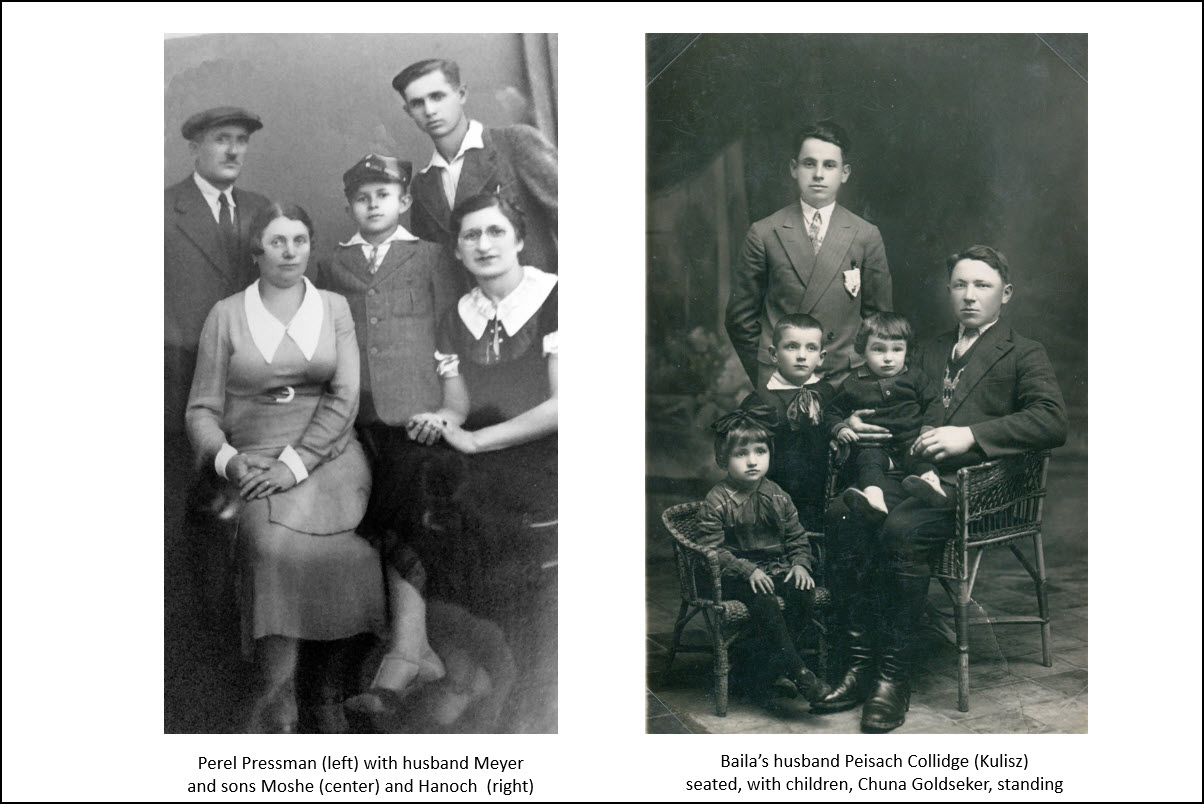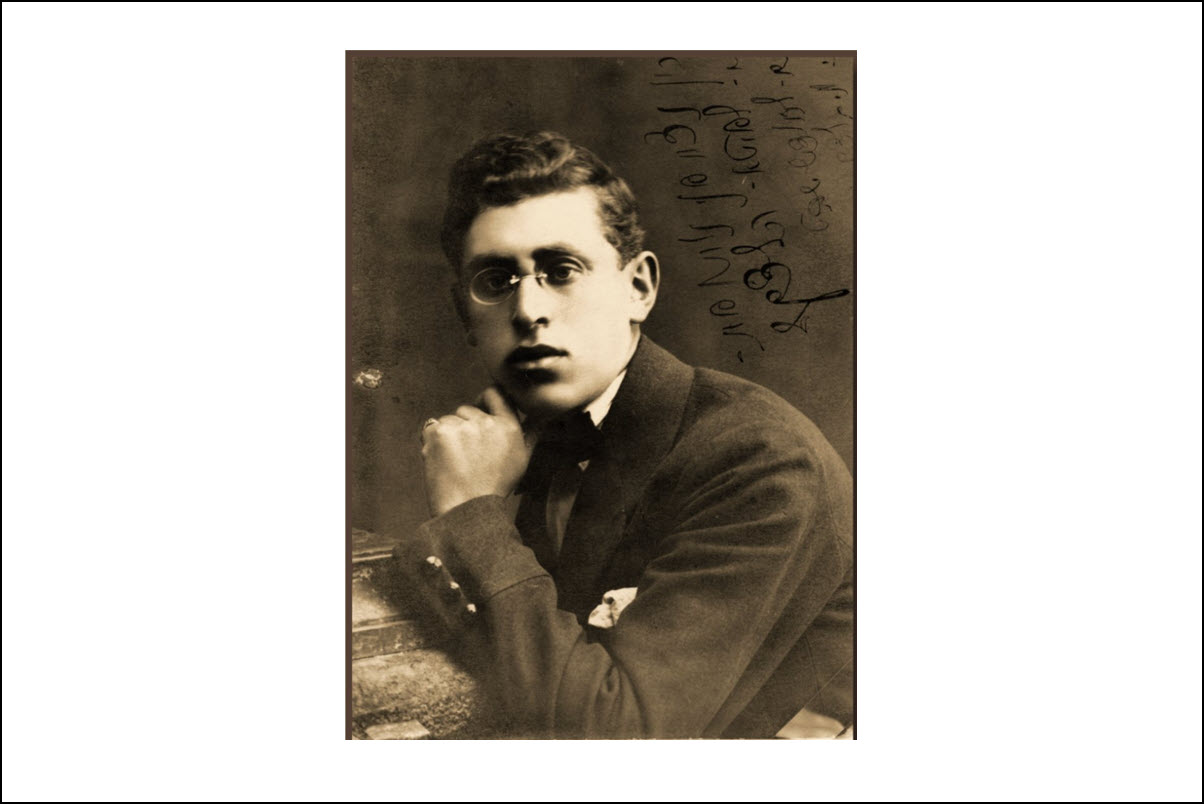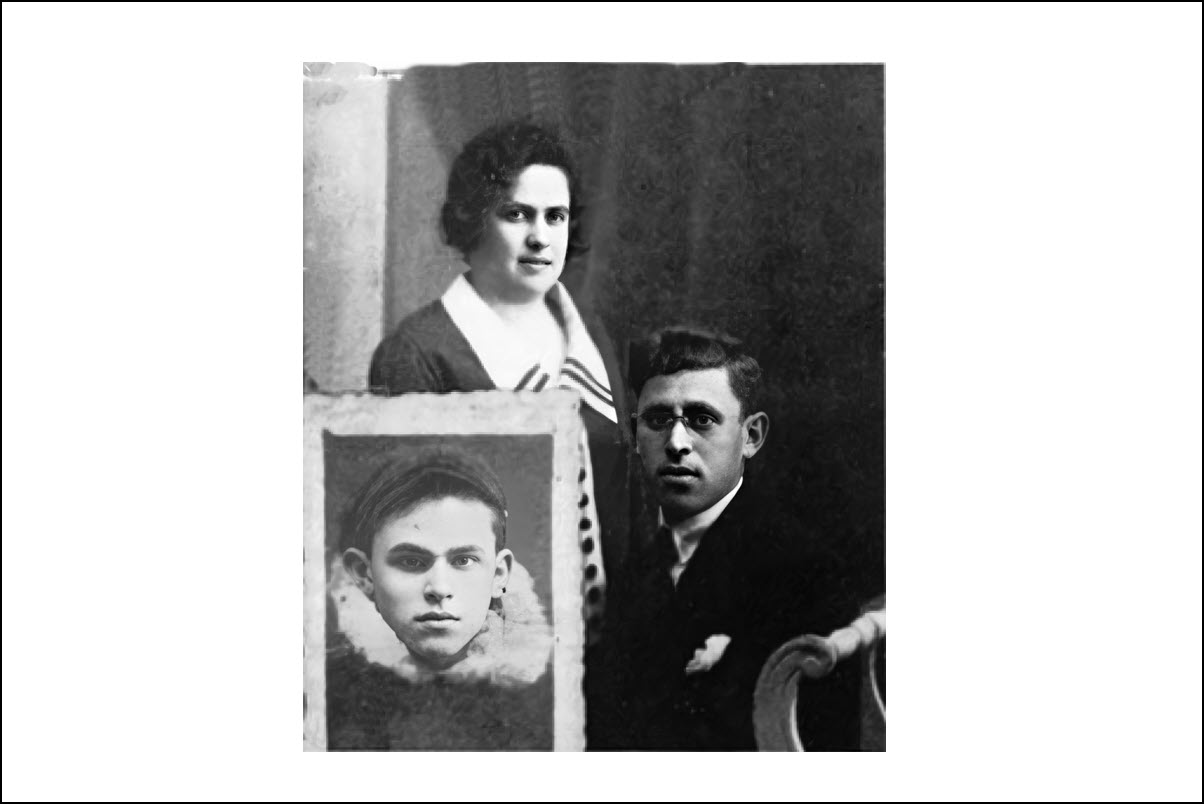-
Home
Home About Network
- History
Nostalgia and Memory The Polish Period I The Russian Period I WWI Interwar Poland WWII | Shoah 1944 Memorial Commemoration- People
Famous Descendants Families from Mlynov Migration of a Shtetl Ancestors By Birthdates- Memories
Interviews Memories 1935 Home Movie in Mlynov 1944 Memorial Commemoration Commemoration Wall- Other Resources
The Goldseker / Holtzeker Family (cont)

***
The Goldseker / Holtzeker Story
As noted earlier, Abraham and Baila Holtzeker had five sons who arrived with them in Mlynov: Hirsch, Moishe, Yankel, Shimon and Yoel. Each of them married and had children and grandchildren.
What we know about these sons and their descendants is summarized in what follows: Hirsch Holtzeker, Moishe Holtzeker, Yankel Holtzeker, Shimon Holtzeker, Yoel Holtzeker.
***
Hirsch Holtzeker
Hirsch was the oldest of the Holtzeker brothers who came to Mlynov. He married a woman named Ida and had five sons and three daughters: Lee (possibly Leah), Aisik (or Yitzhak), Miriam (1870–1942), Yoina, Libba, Gittel, Menucha, Yankel (also called Yantil), and Calman (or Kalman).
Three of Hirsch's grandsons did not perish: Carl Gaynor (1896–1958) (son of Hirsch's daughter Leah), | Boruch Meren (1908–1996) (son of Hirsch's daughter Miriam), | and Micael Givoni (1910–1980) (son of Hirsch's eldest son, Aisik /Yitzhak).
Hirsch's grandson, Boruch, contributed a number of essays and memories to the Mlynov Memorial Book including a poignant story about a gramophone that Hirsch owned before WWI. In "An Event in the Shtetl," Boruch recalls his grandfather:
Of all the Jews in the shtetl, only my grandfather had the honor to go inside the manor, because Hershko was a useful Zhid (Jew). He was a contractor and he worked for the Count. When Jews needed a favor from the Count, my grandfather, Hirsh Goldseker, was the intermediary. Everyone knew that he found favor in the eyes of the Count and the Countess. Everyone in the shtetl talked about how Hirsh Goldseker kisses the Countess's hand when he says hello. My grandfather used to tell us grandchildren wonderful histories of life on the estate. (Mlynov Memorial Book, p. 173 [English volume])
A funny anecdote involving Hirsch's household and three of his children (Gittel, Menucha, and Yankel) is told in the Mlynov Memorial Book by Shmuel Mandelkern in an essay about "Self-defense in Mlynov," pp. 122–23 [English volume]. The anecdote concerns young men in Mlynov who conducted a mock attack on the Holtzeker household around 1919. They did so as part of an effort to solidy support among the elders for their self-defense efforts following the disarray in the countryside after the Bolshevik Revolution. The young men chose the Holtzeker home for the mock attack in part because the senior Hirsch was an important influencer in town and in part due to the beauty of his daughters. The effort terrified Hirsch, his two daughters and a son who were living with him at the time.
Since Hirsch is not listed in the martyr list of the Mlynov Memorial book, we can assume he died before the Shoah.
***
The Martyrs in Hirsch's Line
Hirsch's son, Yankel (called "Yantil" in the anecdote of the mock attack because of his speech impediment), is included in the Goldseker matyrs, along with his wife Rachel, and their children Avraham, Batia, and Tzviya.
Hirsch's son Kalman and his wife Dina are listed among the Goldseker martyrs. This Dina Holtzeker may be the same one who came under scathing criticism for collaborating with the Russians when they occupied Mlynov in 1939 as discussed by Yosef Litvak in "The Town of Mlynov," p. 266 [English volume].
Hirsch's son Aisik/ Yitzhak perished with his wife, Perel Schohet (née Gelman)[2] and their son Aba (his photo below). Aisik's other son Abraham also perished with his wife. Their daughter, Malka, perished with her husband Mordechai Shefer (or Shiper). No children are listed for them in the matyr list. Aisik and Perel's son, Srul (Yisrael) (1906–1942), perished with his wife Shifra Kotch (or Kotel) (1915–1942) and their two children, Rachel, age 5 and a 1 year old child whose name is forgotten, according to Yad Vashem records filled out by a surviving brother of Shifra's, Abraham Kotsh (also called Avraham Abrasha Abraham Kotel). Aisik and Perel's daughter Baila sent photo postcards to her cousin "Zeen" in Baltimore (see below). No additional information is known about her. As noted earlier, Aisik and Perel's son, Micael (1910–1980), made aliyah before WWII. He studied and lived in Mikve Israel, a youth village and boarding school established in 1870 and the first Jewish agricultural school in what is now Israel. Micael wrote letters to his siblings begging them to make aliya, but they didn't believe Hitler would reach Mlynov. In Palestine, Micael Hebraicized his Diasporean name of "Holtzeker" (meaning "wood chopper") to Givoni, the name in the Hebrew Bible for the Gibeonite people who were known as "hewers of wood" (Joshua 9:27). Micael's granddaughter, Sari Fishman, indicates Micael may have had 9 siblings who perished, though not all their names are known.
Hirsch's daughter, Miriam (1870–1942), married Ben Tzion Meren (1867–1942). She perished with her husband and their daughter Seril. Their son, Boruch Meren, made aliyah in 1938 with the help of his then sweetheart, Rosa Berger, who made aliyah in 1933, in a story told elsewhere on this website. Were it not for this relationship, Boruch would have perished with his family. When his relationship with Rosa didn't work out, word reached Mlynov-born Milka (Amelia) Shargel who by then was in Baltimore. She traveled to Palestine where she and Boruch married. In 1940, Boruch left Palestine for Baltimore. He later contributed a number of essays and memories to the Memorial book.
Hirsch's daughter, Leah (probably "Lee" in Baltimore family tree) married Elia Aron Gaynor (or Gener). The Geners are not listed in the martyr list, but a photo (below) shows Leah with her two sons and two or three daughters, with spouses and grandchildren, around her. Leah sent this family photo to her son, Carl, who had already migrated to New York in 1913. Carl traveled as "Kalmen Giner" from Trieste, Italy on the SS Belvedere and arrived in New York on Sept. 18, 1913. As far as we know, the rest of Carl's family perished. According to an unverified oral family tradition recalled by Gelberg descendant, Edith Geller, who remembers Carl as her cousin she visited in New York growing up, Carl's paternal grandmother (i.e. Elia Aron's mother) may have been the sister of Labish Gelberg (who is an ancestor in the Gelberg family).
***
Moishe Holtzeker
Moishe, was the second oldest of the Holtzeker brothers. He married a woman named Ida (Chaya) and had 5 sons and 5 daughters. Moshe's ten children are listed in the Baltimore version of the tree as: Yankel [or Yaakov], Benne [possibly Ben-Tzion], Pincas, Nahum, Golda, Yeshea [or Yehoshua], Baila, Ruchel, Shisha (also spelled "Tchize") and Rivka. For reasons that are not entirely clear, this Moishe is referred to as "Moshe Nahmanis" Goltzeker in the list of Mlynov martyrs.[1]
One of Moishe's grandsons migrated to Baltimore in 1912. His name was Morris Fishman (~1896–1981). He was the son of Moishe's daughter Shisha ("Tchize") who married David Fishman (a sibling of Moishe and Anna Fishman). He traveled from Bremen to Pennsylvania on the SS Neckar under the name of "Mojichs Fischman" arriving on Nov. 22, 1912. He was traveling with a friend, Mlynov-born Nathan Gruber, and headed to Baltimore to the home of his aunt, Sarah (Fishman) Schwartz and her husband Israel Schwartz. In the US, he married Hilda Alpert and they had one daughter Charlotte Fishman (1929–2010).
Three of Moishe's grandchildren made aliyah before the 1942 and one survived the Shoah, as reported by his Israeli great-granddaughter, Lior Wildikan Ganor. They were the children of Moshe's son, Yankel. Yankel married a woman named Risa and had at least 11 children: Tzipporah, Baila, Nahman, David, Menashe, Chana, Mindel, Bayta and Liba, and Hanoch. (Yad Vashem records have slight variations on these names and one record lists a son named Asher). A photo of their large family appears in the Memorial Book as well as their nice house in Mlynov (see below).
Yankel's daughter Tzipporah Sulovsky-Holtzeker (1910–1986) (standing in the photo with her hand on her mother's shoulder) did her prepatory training in Rovno (as part of Kibbutz Haaliya Wolynia b) and made aliyah in 1933. She eventually settled in Kibbutz Negba.
Yankel's son, Nahman, (standing next to Tzipporah in the photo) also made aliyah during this period (the exact year is not known). He took the name "Carol (or Karule) Levi" ( קרול לוי) at some point and some Yad Vashem records are submitted by his daughter, Khaia David (née Levi Holtzeker).
Yankel's daughter Baila (Holtzeker) Wildikan (1914–1990) (standing next to Nachman with her hand on her mother's chair) was involved in the Zionist youth group, Hashomer Hatzair, and after preparatory training (hachsharah) was initially prevented from making aliyah. Finally in 1941 she took leave of Mlynov and made a dangerous journey from Moscow to Odessa and then took a rickety boat to Turkey. She continued by land to Syria and Lebanon until she finally made her way to Mandate Palestine where she joined her sister Tzipporah in Kibbutz Negba. Baila contributed an essay to the Memorial Book, 384-386 [English volume] about her family and taking leaving of Mlynov. She also included a tribute to her brother, Hanoch, who was tragically killed defending Kibbutz Negba on May 25, 1948 during the War for Independence.
Yankel's son Hanoch (1930–1948), was 9 years old when WWII broke out. Together with several of his older brothers, he fled to the forest. He was probably with his brothers, David and Menashe, who were remembered as being in a bunker in the forest near the bunker of Fania (Mandelkern) Bernstein, who wrote about her survival experience in the Memorial Book, p. 278 (English volume). She recalls one time when Menashe came to their bunker and shooting broke out and they had to flee. On another occassion Fania ran into David who reported on the deaths of others from that attack (p. 285, English volume). Menashe must have survived because Asher Teitelman in his survival story, p. 37, recounts that he and Menashe volunteered to join the Red Army together after the Russian Liberation. Asher recalls that after they enlisted they were brought to Bransk, though they were separated when Asher went to officer training camp. Asher was wounded at the front soon thereafter. He met Menashe again in the hospital as he was recovering. That is the last time he saw Menashe Holtzeker.
According to accounts of descendants, Hanoch, the youngest of this family, was with several of his brothers when they were shot and killed. He was injured in the head and the Germans left him for dead. Hanoch managed to crawl to a hiding place where he found a family he knew. Together they fled to Russia and eventually returned to Poland where he located an orphanage and connected with the Zionist youth group, Hashomer Hatzair. With them, he left Poland and eventually joined an illegal ship headed to Palestine. (He was on the same ship with Teitelman family survivors, according to the survival account of Asher Teitelman which can be downloaded here). Close to shore, Hanoch jumped in and tried to swim to shore but he was captured by the British and interred in Cypress for 8 months, as were the Teitelmans. Finally, he joined his sisters in Kibbutz Negba in 1947.
***
The Martyrs in Moishe's Line
Moishe's son named "Benne" according to the Baltimore Goldseker family tree is probably the man named Ben-Tzion Goldseker in the martyr list (Memorial Book, p.399, English volume). Ben-Tzion married Ester-Mania from the line of Pesach Feldman from Boremel. They perished with their children, Avraham and Rivkah. The son, Avraham, is remembered in the Memorial Book, p. 272 (English volume) as one of the leaders of young people who helped acquire two rifles and organize resistance towards the end. The martyr list indicates another son, Pesach, was killed in the Russian military.
Moishe's son Nahum Goldseker perished with his wife Henia Erlikhman (daughter of a man named Nahman from Dobryatyn). Information about the family comes from the Goldseker martyr list (p. 399 English volume) supplemented by Yad Vashem records filled out by Henia's brother, Abraham Erlikhman and sister, Sara Erlikhman. Nahum and Henia perished with their unmarried children, Nahman (1915–1942), Yaakov ("Yankele") (1920–1942), Avraham, Feiga, and Pinya (1922–1942). Their son Rafael (Ralph Golz) (1919–2011) survived. According to Ralph's obituary, at the age of 18, he was drafted into a Russian labor camp. He remained there through World War II working in a logging camp. After the war he returned home to find his town destroyed and his family killed by the Nazis. After spending a few years in a refugee camp he contacted a distant relative in Philadelphia who assisted him with his immigration to the United States.
Moishe's son Yeshea / Yehoshua ("Shika" Goldseker) perished with his wife Sima, and three children Avraham, Batya, and Yosef, according to the Goldseker section of the martyr list (p. 399 English volume). A man in the household named "Nahman from the Gelberg line" is also listed as perishing. A son of Yehoshua and Sima named Pincas is listed as alive in Russia when the Memorial volume was published (martyr list, English volume p. 399). See photos below. A Yad Vashem record submitted by Mlynov-born Moshe Isakovich, a friend of one of the sons, indicates Sima's birth surname was Gelberg and she was the daughter of the mill owner Yosel Gelberg and his wife Sara-Dvorah. The records indicate Yeshea/Yehoshua was born in 1898, his daughter, Batya, in 1930, and Avraham in 1926.
Moishe's daughter, Baila, married Gershon Gelberg, according to the list of Gelberg martyrs in the Memorial book, p. 400 (English volume). According to Boris Gelberg, a great-grandson of Yosel, Gershon was a son of Yosel Gelberg, the mill owner. Since Baila married Gershon and her brother (Yeshea/Yehoshua) married Gershon's sister Sima, it thus appears that two siblings married two siblings (i.e. a son and daughter of Moishe married a daughter and son of Yosel Gelberg!). Baila and Gershon perished with their children Yitzhak, Pinhas, Avraham and Ester. Baila sent photo postcards to her cousin "Zeen" (Sam) Goldseker in Baltimore (see below).
Moishe's daughter, Rivka (Holtzeker) perished with her husband Tzvi Fisher (1908–1942). A photo of them from the Mlynov book appears below. No children are listed.
Moishe's daughter, Golda (Holtzeker), married Mendel Shek (or Shak), and they perished with children: Avraham, Dvorah, Freidil, and Baila, according to the Mlynov martyr list (see p. 439 in Hebrew original, English volume is incorrect). The son Avraham Shek was briefly encountered by David Bernstein while in hiding with a Czech farmer as recounted in the Memorial Book (p. 286 English volume). Avraham was hiding there with others from Mlynov, including survivor Koppel Messinger, and two Hochberg sisters. Someone snitched on them and Avraham was killed by Banderite men shortly after David saw him . The others escaped.
Moishe's daugther Shisha ("Tchize") married David Fishman (a sibling of Moishe and Anna Fishman). According to oral traditions in the Baltimore line, Shisha's husband, David, died young, probably by 1899 when his brother Moshe Fishman named his eldest son David. The Baltimore version of the Goldseker tree indicates Shisha and David had four sons: Herschel, Moishe (Morris), Gershon, and Kalman. Shisha and David's son, Kalman, is probably the man named Kalman Fishman in the Mlynov martyr list. He perished with his wife, Chaya, and sons Pesach, David, Shimon, Asher and Yosel. According to Yad Vashem records submitted by survivor Yaakov Goldseker, Kalman's son David Fishman married a woman named Nuna Shkolnik (1912-1942), his father's second cousin. Nuna was the daughter of Yoel Holtzeker's daughter, Liba who married Chaim Shkolnick. Thus, Yoel Holtzeker's granddaughter Nuna married Moshe Holtzeker's great-grandson, David Fishman. [You can visualize the relationship this way: Yoel Holtzeker->his daughter Liba (Shkolnik)->her daughter Nuna (Shkolnik) married -> David Fishman, her husband-> his father Kalman Fishman->his mother, Shisha (Holtzeker)->her father Moishe Holtzeker.]
***
Yankel [Yaakov] Holtzeker
Yankel was the third of the five Holtzeker brothers to come to Mlynov. He married a woman named Rivkah and had two sons: Yehoshua (1878-1942) ("Yeshea" in the Baltimore Goldseker tree) and Moishe (1880-1942).
Yankel had three grandchildren known to have survived. Two of those grandchildren were children of his son Moishe.
Moshe's son Avraham (1913–1998) made aliyah with the youth group, Betar, in August 1939, just before the start of WWII. Avraham had two children of his own: Yeshea (1942–) and Moshe (1947–). Moishe's other son who survived was named Yankev (or Yaakov (1920–2006), for his grandfather who likely died before he was born. This younger Yankev survived the Shoah in the Red Army and returned to Mlynov after the War to find it completely destroyed. He wrote about his memories and experience in the essay, "My Hometown Mlynov" in the Memorial Book, English volume, pp. 210-212 (English volume). Yaakov had a son, Moshe, in 1947 who was born in Italy and the family made aliyah that year. Moshe in turn had three children.
A daughter Pesie was living in Israel in 1970 when the Memorial Book was published, according to the list of martyrs in the Memorial book.
Matyrs in Yankel's Line
Yehoshua (1878-1942) perished with his wife Tova from Berestchko, and their children: Avraham (1912-1942) a clerk and single, Rivkah (1910-1942) a seamtress and married and lived in Lvov, and Beracha (Bejla) (1903-1942) a seamstress who was living in Luck before the War.
Moishe (1880-1942) perished with his wife Tova [Kaliner or Kline] (1890-1942) from the line of R. Reuven Ostriyever [=Ostrog] with their children: Yona Reuven (1907-1942) and his wife Roza, Chaya Baila (1905-1942) who was a seamstress and single, Rivkah (1912-1942) who married Avraham Kolton, Genendel (or Genia) (1916-1942), and Pesia a seamstress and single (1918-1942).
***
Shimon Holtzeker
Shimon was the second youngest of the Holtzeker brothers and he was the brother we know the most about. He born in 1867 and died in Mlynov in 1926 at the age of 59. He probably was a very young boy or baby when his family left Dubno for Slobada, where he probably grew up. He married Anna Fishman, the sister of Moishe Fishman. Anna was born in Mlynov in 1876 and died in 1914 at the age of 47. The marriage of Shimon and Anna, forever intertwined the Fishman and Goldseker families.
Anna (Fishman) and Shimon Goldseker were the parents of twelve children, eight of whom grew to adulthood. The eight children were: Chaiya (Ida) (Goldseker) Fishman Gresser , Peyrel also known as "Pearl" (Goldseker) Pressman, Eta (Goldseker) Fishman, Moishe (Morris) Goldseker, Baila (Goldseker) Collidge, Charna (Goldseker) Gruber, David (also known as "Sonny" or "Sam") Katz/Goldseker, and Chuna (Juan) Goldseker.
Four of Shimon and Anna's children migrated to Baltimore. Ida Goldseker married her uncle Meyer Fishman by 1907 when their son Ben was born. Meyer left for Baltimore in 1909. In 1912, Ida (listed as "Chaje Fishman") and son Ben left Bremen and traveled to Philadelphia on the SS Brandenburg, arriving Jan. 27, 1912. She and Meyer divorced not long afterwards and she remarried Sam Gresser, who adopted her son Ben. They had two other children.
Next to arrive in the US was Ida's younger brother Moishe (Morris). "Mojochs Goldzheker" traveled from Bremen to Baltimore on the SS Rhein, arriving Aug. 28, 1913. Morris Goldseker was very successful in real estate in Baltimore starting in 1917 and upon his death established the Goldseker Foundation, the largest foundation in Maryland. The foundation has granted $118 million to more than 600 nonprofit organizations and projects in Baltimore.
David Goldseker (called Sam or Sonny) arrived in Baltimore in 1926 via a via a perilous journey and a several year stay in Beunos Aires. Several other Mlynov immigrants who couldn't get into the US during the mid 1920s due to quotas came via Buenos Aires. A photo of Sam and friends in Buenos Aires during this time includes several other Mlynov-born young men who have been identified. After Sam arrived in the US, he took the surname Katz.
Eta Goldseker immigrated to Palestine in 1926 to marry her first cousin, David "Dudek" Fishman (son of Moishe Fishman). Their first daughter, Selma, was born there in 1926. After a number of difficult years living with David's family on Moshav Balfouria, the family made the difficult decision to leave for Baltimore in 1929. They were among many immigrants leaving the difficult and dangerous life in Palestine at this time. Their daughter, Irene, was born in Baltimore in 1929. Eta and Sonny maintained their extremely close relationship throughout their lives until Eta's death in 1989, at the age of 92.
Chuna Goldseker, the youngest brother, followed his brother Sonny's path to Beunos Aires where Chuna married, settled and raised a family. Sadly, his daughter, Ana, died at the young age of sixteen. In 1965, Chuna's son, Simon along with his wife and one yearold baby, Ana, came to the US.
***
Martyrs in Shimon's Line
The other Goldseker siblings perished in the Shoah.
Perel Goldseker (1893–1942) married Meyer Ben Zion Pressman and moved to Trovits (today Torhovytsya, Ukraine). They and their son Hanoch perished. Their younger son Moishe managed to escape from the ghetto and survive for three years, in a story told by Reuven Raberman in the Trovits Memorial Book. With the Russian Liberation, Moishe joined the Red Army to take revenge. He was last seen at the battle of Koenigsberg.
Baila Goldseker (1897–1942) married Peisach Collidge (also Kulisz). They and their five children perished.
Charna Goldseker (1898–1942) married Shmuel Gruber. Shmuel was one of the ones who helped create the bunkers outside of Mlynov. He, his wife, Charna, and two children, were in the bunkers before they were discovered and killed, according to an account in the Memorial book, English volume, pp. 293-294, 298.
***
Yoel Holtzeker
Yoel was the youngest of the Holtzeker brothers who came to Mlynov. Not as much information is recovered about his family. What is known of this family line comes from the list of martyrs in the Memorial Book some Yad Vashem records submitted by a a Mlynov neighbor Moshe Iskiewicz (Isakovich), a survivor listed as "Y. Goltzeker," who submitted Russian records, and a cousin Tania Feldman. It is unknown how Tania Feldman is related.
Yoel Holtzeker married a woman named Basa. The Baltimore family tree lists the names of 5 children: Liba, Rochelle ("Risl" in the list of martyrs and Yad Vashem records), Moishe, Chaiyz (called Chaika in Yad Vashem records and Chaya in the martyr list) and Baila.
Shmuel Mandelkern in his essay on "Self-Defense in Mlynov," page 112 [English volume] briefly mentions Yoel's house when he was describing where the defense brigades guarded. He writes, "We broke into 4 brigades. The role of one brigade was to guard Shkolna Road, which began at the corner of the house of Yoel Goldseker, and ended at the last house on the street, at the home of Yose Meir's (son). The role of the second unit was to guard the road that began from Yoel Goldseker to the Shulman house."
From Yad Vashem records submitted by Moshe Iskiewicz (Isakovich), a Mlynov neighbor and a contributor to the Mlynov Book, it appears that one grandson survived in Russia. His name was "Yoel," a namesake of his grandfather, and he was the son of Yoel's son, Moishe, a merchant, and his wife Liuba (née Valder) (1904–1942) who was from Dubno. Moishe and Liuba are listed as martyrs along with their daughter, Batya, age 10, and son Mordechai age 12. A sister, Chaya / Chaika (possibly Moishe's sister), is listed as having perished with his household as well. Records submitted in Russian to Yad Vashem by "Y. Goltzeker" appear to be from this surviving grandson, Yoel, though some of the names are Russian and don't match precisely the names in the list of martyrs. It is uncertain what became of this grandson Yoel.
***
The Matyrs in Yoel's Line
What we know of Yoel's descendants from the martyr list and Yad Vashem records:
Yoel's daughter Liba is listed in the martyr list, as marrying Chaim Shkolnik. They perished with their children: Avraham, Chasia, Eliyahu, and Batya. In Yad Vashem records, a daughter named Nuna is identified as marrying a cousin David Fishman, who was the grandson of Moshe Nahmanis's daughter Shisha.
[You can visualize the relationship of cousins this way: Yoel Holtzeker-> his daughter Liba (Shkolnik)-> her daughter Nuna (Shkolnik) married -> her cousin David Fishman -> his father was Kalman Fishman-> Kalman's mother was Shisha (Holtzeker)-> her father was Moishe Holtzeker.]
Risel is described as the daughter of R. Yoel and the widow of Pinhas Holtzeker. It seems probable based on this description that she married her first cousin, Pincas, son of Moishe Holtzeker. Risel perished with her married daughter Tovah (also called Tebel in the records), born in 1912, and her son Avraham, born in 1915 and single.
Return to the top or to the beginning of the Goldseker / Holtzeker Story.
***
Notes
[1] The name "Moishe Nahmanis" appears to be a possessive construction that in Yiddish means "Nachman's Moishe." Normally this construction in the Mlynov Memorial book is used to describe a child by his or her father's name, as in Henye Ahrelas, which means Henye daughter of Aharon. At times, it is also used to describe a person based on his mother's name (e.g., if his father has passed) as in "Moishe Toybes," meaning Moishe [Fishman] son of Toba. In this case, neither Moishe's father nor mother are named Nahman (or Nahama) and thus it is uncertain where the name originates. This nickname probably helped distinguish this Moishe Goltzeker from his brother Yankel's son who is also called Moishe Goltzeker. There is a grandson named Nachman (son of Moishe's son Yankel) which seems to confirm that the name Nahman was important in this family line. It is also interesting that a Nachman Gelberg is a father-in-law living in the household of Moishe Goltzeker's son, Yeshea/Yehoshua, who married Sima Gelberg. Perhaps the nickname "Moishe Nahmanis" came from his son's father-in-law. While it remains unclear why this Holtzeker son is called Moishe Nahmanis, it seems highly probable that this Moishe Holtzeker is the man with that nickname since the individuals called sons and daughters of Moishe Nahmanis in the Mlynov martyr list correspond to the names of children recorded by the Baltimore family for this Moshe Holtzeker. ↩
[2] Aisik's wife Perel is called the "daughter of Itzi Shochet" in the listing for Aisik Goldseker in the Goldseker martyrs from Mlynov [p. 399 English translation]. Descendants interpret "shochet" to be a surname. However there is indication that "shochet" was in fact a nickname/description (Itzi the kosher slaughterer), not a surname. In the list of Mlynov martyrs, Pesach Gelman is described as a shohet and scribe and called the son of "R. Itzi the shohet" (see page 433 in the original and 400 for the English translation]. I have concluded that Itzi the shochet had the last name Gelman and that Perel was his daughter and had the surname Gelman. ↩
***
Compiled by Howard I. Schwartz
Updated: July 2024
Copyright © 2021 Howard I. Schwartz, PhD
Webpage Design by Howard I. Schwartz
Want to search for more information: JewishGen Home Page
Want to look at other Town pages: KehilaLinks Home Page
This page is hosted at no cost to the public by JewishGen, Inc., a non-profit corporation. If it has been useful to you, or if you are moved by the effort to preserve the memory of our lost communities, your JewishGen-erosity would be deeply appreciated.
- History
